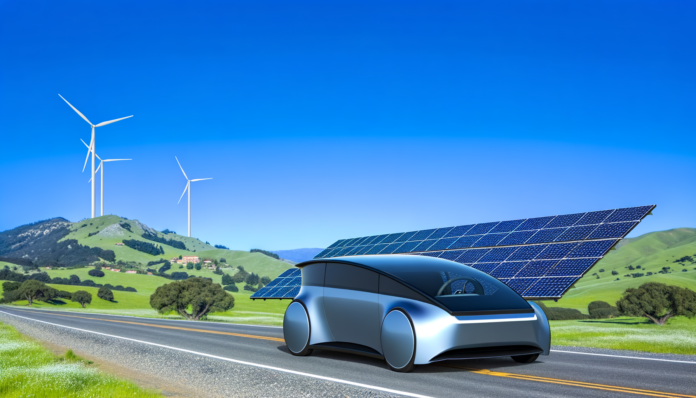Introduction
Overview of Zero Emissions Goal
The global push towards zero emissions is a critical response to the escalating climate crisis. Governments, corporations, and individuals are increasingly recognizing the urgent need to reduce greenhouse gas emissions to mitigate the adverse effects of climate change. The transportation sector, which accounts for a significant portion of global emissions, is a primary focus in this endeavor. The goal is to transition to zero-emission transportation systems by 2050, a target that aligns with international agreements such as the Paris Agreement. Achieving this ambitious goal requires a multifaceted approach, including the adoption of renewable energy sources, advancements in technology, and supportive policy frameworks.
Importance of Solar Powered Transportation
Solar powered transportation stands out as a pivotal component in the journey towards zero emissions. Unlike traditional fossil fuels, solar energy is abundant, renewable, and emits no greenhouse gases during operation. By harnessing the power of the sun, solar powered vehicles can significantly reduce the carbon footprint of the transportation sector. This shift not only addresses environmental concerns but also promotes energy independence and security. Solar powered transportation encompasses a range of technologies, from solar panels on electric vehicles to solar-powered charging stations, each contributing to a cleaner and more sustainable future.
Target Audience and Relevance
This article is intended for a diverse audience that includes policymakers, environmental advocates, industry professionals, and the general public. Policymakers will find insights into the regulatory and infrastructural changes needed to support solar powered transportation. Environmental advocates can use the information to bolster their campaigns for cleaner energy solutions. Industry professionals, particularly those in the automotive and energy sectors, will gain an understanding of the latest technological advancements and market trends. Lastly, the general public will learn about the benefits of solar powered transportation and how they can contribute to a zero-emission future. The relevance of this topic cannot be overstated, as it intersects with critical issues such as climate change, public health, and economic development.
The Basics of Solar Powered Transportation
How Solar Power Works
Solar power harnesses energy from the sun using photovoltaic (PV) cells, which convert sunlight directly into electricity. These cells are typically made from semiconductor materials like silicon. When sunlight hits the PV cells, it excites electrons, creating an electric current. This electricity can then be used immediately or stored in batteries for later use. Solar power is a clean, renewable energy source that produces no greenhouse gas emissions during operation, making it an ideal candidate for sustainable transportation solutions.
Types of Solar Powered Vehicles
Solar powered transportation encompasses a variety of vehicle types, each utilizing solar energy in unique ways:
- Solar Cars: These vehicles are equipped with solar panels on their roofs or bodies to capture sunlight and convert it into electricity. They are primarily used for short-distance travel and are often seen in solar car races.
- Solar Buses: Public transportation buses can be fitted with solar panels to power their electric motors. This reduces their reliance on fossil fuels and lowers operational costs.
- Solar Trains: Trains can also benefit from solar power. Solar panels can be installed on train carriages or at stations to provide energy for propulsion and onboard systems.
- Solar Boats: Boats and yachts can use solar panels to power their electric engines, reducing the need for diesel fuel and minimizing water pollution.
- Solar Planes: Although still in the experimental stage, solar planes use solar panels to generate electricity for their engines, offering a glimpse into the future of aviation.
Current Technologies and Innovations
The field of solar powered transportation is rapidly evolving, with several cutting-edge technologies and innovations making significant strides:
- High-Efficiency Solar Panels: Advances in PV cell technology have led to the development of high-efficiency solar panels that can capture more sunlight and convert it into electricity more effectively. This increases the range and performance of solar powered vehicles.
- Solar Paint: Researchers are developing solar paint, which can be applied to the surface of vehicles to generate electricity. This innovation could potentially turn any vehicle into a solar powered one.
- Integrated Solar Roofs: Some electric vehicle manufacturers are incorporating solar roofs into their designs. These roofs can provide additional energy to extend the vehicle’s range and reduce the frequency of charging.
- Solar Charging Stations: Solar powered charging stations are becoming more common, providing a sustainable way to recharge electric vehicles. These stations use solar panels to generate electricity, which is then stored in batteries or fed directly into the grid.
- Energy Storage Solutions: Advances in battery technology are crucial for the success of solar powered transportation. High-capacity, long-lasting batteries can store excess solar energy, ensuring that vehicles have a reliable power source even when sunlight is not available.
In summary, solar powered transportation leverages the abundant and renewable energy of the sun to power various types of vehicles. With ongoing advancements in solar technology and energy storage, the potential for solar powered transportation to significantly reduce greenhouse gas emissions and promote sustainability is immense.
Environmental Impact
Reduction in Greenhouse Gas Emissions
Solar-powered transportation offers a significant reduction in greenhouse gas emissions compared to traditional fossil fuel-based vehicles. Unlike internal combustion engines, solar-powered vehicles generate zero emissions during operation. This is a crucial advantage in the fight against climate change, as the transportation sector is one of the largest contributors to global greenhouse gas emissions. According to the U.S. Department of Energy, electric vehicles (EVs) already produce fewer emissions over their lifetimes compared to gasoline-powered cars, and solar-powered vehicles can further enhance this benefit by utilizing renewable energy directly from the sun.
Decreased Dependence on Fossil Fuels
One of the most compelling advantages of solar-powered transportation is the decreased dependence on fossil fuels. Fossil fuels are a finite resource, and their extraction and use have numerous environmental and geopolitical consequences. By harnessing solar energy, we can reduce our reliance on oil, coal, and natural gas, thereby mitigating the environmental degradation associated with their extraction and combustion. Solar-powered vehicles, by generating their own energy, can operate independently of the traditional fuel supply chain, offering a more sustainable and resilient transportation solution.
Impact on Air Quality and Public Health
The adoption of solar-powered transportation can have a profound impact on air quality and public health. Traditional vehicles emit pollutants such as nitrogen oxides (NOx), particulate matter (PM), and volatile organic compounds (VOCs), which contribute to smog and respiratory problems. Solar-powered vehicles, on the other hand, produce no tailpipe emissions, leading to cleaner air and a reduction in health issues related to air pollution. Improved air quality can result in fewer cases of asthma, bronchitis, and other respiratory conditions, ultimately enhancing the quality of life for urban populations.
In summary, solar-powered transportation offers substantial environmental benefits, including a reduction in greenhouse gas emissions, decreased dependence on fossil fuels, and improved air quality. These advantages make solar-powered vehicles a promising solution for achieving a sustainable and healthy future.
Economic and Social Benefits
Cost Savings Over Time
One of the most compelling economic benefits of solar-powered transportation is the potential for significant cost savings over time. While the initial investment in solar-powered vehicles and infrastructure can be substantial, the long-term savings are noteworthy. **Solar energy is free**, and once the solar panels and batteries are installed, the cost of fuel drops to zero. This is a stark contrast to traditional vehicles that rely on fossil fuels, which are subject to price volatility and ongoing expenses.
Moreover, solar-powered vehicles typically have lower maintenance costs compared to their internal combustion engine counterparts. Electric motors have fewer moving parts, which reduces the likelihood of mechanical failures and the need for frequent repairs. Additionally, the lifespan of solar panels can extend up to 25-30 years, providing a long-term, reliable source of energy. Over time, these factors contribute to a lower total cost of ownership, making solar-powered transportation an economically viable option.
Job Creation in the Renewable Energy Sector
The shift towards solar-powered transportation is not only beneficial for the environment but also for the economy, particularly in terms of job creation. The renewable energy sector, including solar energy, is a significant source of employment. According to the International Renewable Energy Agency (IRENA), the solar industry alone has created millions of jobs worldwide, spanning manufacturing, installation, maintenance, and research and development.
**Job creation in the renewable energy sector** is multifaceted. It includes roles in the production of solar panels, the development of new technologies, and the installation and maintenance of solar-powered infrastructure. Additionally, as the industry grows, there is an increasing demand for skilled professionals in engineering, project management, and environmental science. This not only helps to reduce unemployment rates but also fosters economic growth and innovation.
Enhanced Energy Security
Solar-powered transportation can significantly enhance energy security by reducing dependence on fossil fuels. Fossil fuels are finite resources, and their extraction and distribution are often subject to geopolitical tensions and market fluctuations. By contrast, solar energy is abundant and widely available, providing a more stable and predictable source of energy.
**Energy independence** is a critical aspect of national security. Countries that invest in solar-powered transportation can reduce their reliance on imported fuels, thereby mitigating the risks associated with supply disruptions. This is particularly important for regions that are heavily dependent on oil imports. By harnessing solar energy, these regions can achieve greater energy autonomy and resilience.
Furthermore, the decentralization of energy production through solar-powered transportation can enhance the resilience of the energy grid. Distributed solar power systems, such as solar-powered charging stations, can reduce the strain on centralized power plants and improve the overall stability of the energy supply. This is especially beneficial in the face of natural disasters or other emergencies that can disrupt traditional energy infrastructure.
In conclusion, the economic and social benefits of solar-powered transportation are substantial. From long-term cost savings and job creation to enhanced energy security, the transition to solar energy offers a promising pathway towards a more sustainable and resilient future. As technology continues to advance and the adoption of solar-powered transportation grows, these benefits are likely to become even more pronounced, driving further investment and innovation in the renewable energy sector.
Challenges and Limitations
Technological Barriers
Solar-powered transportation, while promising, faces significant technological barriers. One of the primary challenges is the limited range of solar-powered vehicles. Current battery technology restricts the distance these vehicles can travel on a single charge, making them less suitable for long-distance travel. Additionally, the efficiency of solar panels is another concern. Although advancements are being made, the current photovoltaic cells can only convert a fraction of sunlight into usable energy, which limits the overall performance of solar-powered vehicles.
Moreover, the performance of solar-powered vehicles can be significantly affected by weather conditions. In areas with limited sunlight or during seasons with shorter daylight hours, the efficiency of these vehicles drops, making them less reliable. Extreme weather conditions, such as heavy rain or snow, can also impact the functionality of solar panels and the overall performance of the vehicle.
Infrastructure and Implementation Issues
The infrastructure required to support solar-powered transportation is still in its nascent stages. Unlike traditional fossil-fuel-powered vehicles, which have a well-established network of fueling stations, solar-powered vehicles require a different kind of infrastructure. This includes solar-powered charging stations, which are not yet widely available. The installation of these stations requires significant investment and strategic planning to ensure they are accessible to users.
Additionally, the integration of solar-powered vehicles into the existing transportation network poses logistical challenges. For instance, urban areas with limited space may find it difficult to accommodate the large solar panels required for charging stations. Rural areas, on the other hand, may face challenges related to the availability of the electrical grid to support these stations.
Economic and Policy Challenges
The economic feasibility of solar-powered transportation is another significant hurdle. The high upfront costs associated with solar-powered vehicles and the necessary infrastructure can be prohibitive for many individuals and businesses. While the long-term operating costs are lower due to the elimination of fuel expenses, the initial investment remains a barrier to widespread adoption.
Policy challenges also play a crucial role in the adoption of solar-powered transportation. Government incentives and subsidies are essential to offset the high initial costs and encourage the development of the necessary infrastructure. However, the implementation of such policies can be complex and may face opposition from various stakeholders, including the fossil fuel industry and consumers accustomed to traditional vehicles.
Furthermore, the regulatory environment needs to adapt to accommodate the unique requirements of solar-powered transportation. This includes setting standards for the installation and maintenance of solar-powered charging stations, as well as ensuring that the electrical grid can support the increased demand for renewable energy.
In conclusion, while solar-powered transportation holds great promise for reducing greenhouse gas emissions and decreasing dependence on fossil fuels, several challenges and limitations need to be addressed. Technological advancements, infrastructure development, and supportive economic and policy measures are essential to overcoming these barriers and realizing the full potential of solar-powered transportation.
Case Studies and Real-World Applications
Successful Solar Powered Transportation Projects
Solar-powered transportation has seen several successful implementations worldwide, showcasing the potential of this technology. One notable example is the Solar Impulse project, which achieved the first solar-powered flight around the world. This project demonstrated the feasibility of solar energy in aviation, paving the way for future innovations in solar-powered air travel.
Another significant project is the Solar Roadways initiative in the United States. This project involves the installation of solar panels on road surfaces, which can generate electricity while supporting vehicular traffic. The generated electricity can be used to power streetlights, traffic signals, and even electric vehicles (EVs) through embedded charging stations.
In the automotive sector, the Lightyear One is a pioneering solar-powered electric car that integrates solar panels into its roof and hood. This design allows the vehicle to charge itself while driving or parked, significantly extending its range and reducing dependence on external charging infrastructure.
Lessons Learned from Early Adopters
Early adopters of solar-powered transportation have provided valuable insights into the challenges and opportunities associated with this technology. One key lesson is the importance of integrating solar power with existing energy systems. For instance, the Solar Impulse project highlighted the need for efficient energy storage solutions to manage the intermittent nature of solar power.
Another lesson is the significance of public and private sector collaboration. The success of the Solar Roadways project was partly due to the support from government grants and private investments. This collaboration facilitated the development and testing of innovative technologies, which might have been challenging to achieve independently.
Moreover, early adopters have underscored the necessity of public awareness and education. The adoption of solar-powered transportation requires a shift in consumer behavior and acceptance of new technologies. Initiatives like public demonstrations and educational campaigns have proven effective in garnering public support and accelerating adoption.
Future Prospects and Innovations
The future of solar-powered transportation looks promising, with several innovations on the horizon. One exciting prospect is the development of solar-powered drones for various applications, including delivery services and environmental monitoring. These drones can operate autonomously, powered by solar energy, reducing the need for frequent recharging and enabling longer flight times.
In the maritime sector, solar-powered boats and ships are gaining traction. Companies are exploring the use of solar panels on vessels to reduce fuel consumption and emissions. For example, the Energy Observer, a hydrogen-powered vessel, utilizes solar panels to generate electricity, showcasing the potential of renewable energy in maritime transportation.
Additionally, advancements in solar panel efficiency and lightweight materials are expected to enhance the performance of solar-powered vehicles. Researchers are working on developing flexible and transparent solar panels that can be seamlessly integrated into various surfaces, including windows and body panels of vehicles. This innovation could significantly increase the surface area available for solar energy capture, further improving the efficiency and range of solar-powered transportation.
In conclusion, the successful implementation of solar-powered transportation projects, lessons learned from early adopters, and future innovations highlight the transformative potential of this technology. As solar power continues to advance, it is poised to play a crucial role in achieving zero emissions in the transportation sector, contributing to a more sustainable and environmentally friendly future.
Conclusion
Summary of Key Points
The journey towards zero emissions in transportation is a multifaceted endeavor that hinges significantly on the adoption of solar-powered vehicles. Throughout this article, we have explored the fundamental workings of solar power, the various types of solar-powered vehicles, and the current technologies driving this innovation. We have also delved into the substantial environmental benefits, such as the reduction in greenhouse gas emissions, decreased dependence on fossil fuels, and improvements in air quality and public health. Additionally, the economic and social benefits, including long-term cost savings, job creation in the renewable energy sector, and enhanced energy security, were highlighted. However, the path is not without its challenges, including technological barriers, infrastructure and implementation issues, and economic and policy hurdles. Real-world applications and case studies have shown both the successes and lessons learned, providing a roadmap for future advancements.
The Path Forward for Solar Powered Transportation
The future of solar-powered transportation is promising but requires concerted efforts across various sectors. Technological advancements must continue to improve the efficiency and affordability of solar panels and battery storage systems. Investment in infrastructure, such as solar-powered charging stations, is crucial to support the widespread adoption of solar vehicles. Policymakers need to create favorable conditions through incentives and subsidies to lower the initial costs and encourage both manufacturers and consumers to make the switch. Collaboration between governments, private sectors, and research institutions will be essential to overcome the existing barriers and accelerate the transition. Public awareness and education campaigns can also play a significant role in driving consumer acceptance and demand for solar-powered transportation solutions.
Call to Action for Readers
As individuals, we have a pivotal role to play in this transition. Here are some steps you can take to contribute to the journey towards zero emissions:
- Educate Yourself: Stay informed about the latest developments in solar-powered transportation and renewable energy technologies.
- Advocate for Change: Support policies and initiatives that promote renewable energy and sustainable transportation solutions. Engage with local and national representatives to push for more robust environmental regulations and incentives.
- Consider Solar Options: If you are in the market for a new vehicle, explore solar-powered or hybrid options. Even small steps, like installing solar panels at home, can contribute to a larger impact.
- Support Renewable Energy Projects: Invest in or support companies and projects that are working towards sustainable energy solutions. Your financial support can help drive innovation and implementation.
- Spread the Word: Share information about the benefits of solar-powered transportation with your community. The more people are aware, the faster we can move towards a sustainable future.
In conclusion, the road to zero emissions through solar-powered transportation is a challenging yet achievable goal. By working together and taking proactive steps, we can significantly reduce our environmental footprint and pave the way for a cleaner, healthier planet. Let’s embrace this opportunity to make a lasting impact on our world.






